Miguel Angel Galluzzi
| Miguel Angel Galluzzi | |
|---|---|
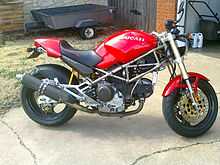 1994 Ducati M900 Monster | |
| Born |
October 26, 1959 Buenos Aires |
| Alma mater | Art Center College of Design |
| Occupation | Motorcycle designer |
| Employer | Piaggio Group |
| Notable work | Ducati Monster |
| Title | Vice President of Design |

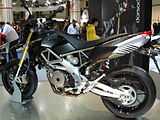
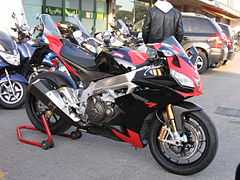

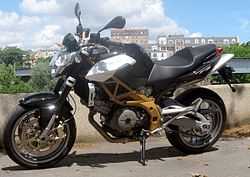
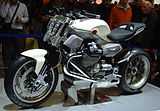
Miguel Angel Galluzzi (Buenos Aires, October 26, 1959) is an industrial designer specializing in motorcycle design who created the Ducati Monster,[1][2][3] an "instant icon that singlehandedly launched the naked bike niche," and "became the company's best selling and most profitable model line and carried the company through many lean years," possibly saving them from ruin.[4][5] The idea of the minimalist Monster began with Galluzzi thinking, "All you need is a saddle, tank, engine, two wheels and handlebars".[6][7] Monsters eventually accounted for two-thirds or more of Ducati's output.[5][8]
Career
Galluzzi is a third generation motorcyclist[4] whose first motorcycle was a 1959 Kreidler Florett 50 he received for his eighth birthday, a present that disappointed him at first because, said Galluzzi, his "head was 100 percent into music" at the time and he wanted a drum set to become like Charlie Watts, though the bike changed the direction of his life.[9] Because Galluzzi is 6 ft 6 in (1.98 m) tall, many of his best known creations with low seat heights and high foot pegs, like the Monster and Raptor naked bikes, are better suited to their target buyer than their designer.[10]
Galluzzi graduated from the Art Center College of Design in Pasadena, California in 1986,[6] from the same Transportation Design program as BMW's David Robb, designer of the R1100RT, K1200RS, R1200C, R1100S and K1200LT.[11] Galluzzi first worked for Opel,[4] and then for Honda's V-Car/Omega design studio in 1988, first in Offenbach, Germany and later in Milan.[4][6][12] In 1989 Galluzzi went to work for Ducati's parent company at the time, Cagiva, in Varese, Italy.[4][6][12] He stayed at Cagiva for 17 years, until July 2006 when he became Styling Director at Aprilia,[13][14] rising to become Vice President of Design for Piaggio Group, Aprilia's parent.[6]
In 2012, Galluzzi relocated from Piaggio's headquarters in Pisa to Pasadena, California to lead the company's new Advanced Design Center.[15][16] The California location follows other branches in China, India, Italy and Vietnam, which work with the main Piaggio Group Style Center, run by Director Marco Lambri.[15] Galluzzi chose the Pasadena location, "because of its proximity to centers of transportation thought," namely the Art Center College of Design, California Institute of Technology, and Jet Propulsion Laboratory.[15] Galluzzi said he is, "looking for the next form of mobility," five to fifteen years into the future, and he will be, "hiring young and creative and crazy people," at the new design center to do, "experiments that might offer a rethinking or a melding of recent mobility concepts".[15] Piaggio and Galluzzi hope to bring a more cosmopolitan perspective than is possible working only in Italy, and branch out to such areas as electric vehicles that combine aspects of a motorcycle and a car, like the Renault Twizy and Audi Urban Concept.[15][16] The Daily Telegraph 's Kevin Ash said, with the Piaggo Group's total US sales, including Aprilia and Vespa, at only 10,000 units in 2011, the new center must also be aimed to bolster sales in that market.[17]
Motorcycle designs
The first work Galluzzi did at Cagiva for Ducati was on the 900 Supersport.[14] While most of the early models of Ducati's Cagiva period are poorly remembered, and the 1990 900 Supersport suffered flaws like splitting fuel tanks, the visually and mechanically revised 1991 900 Supersport, offered in full- and half-fairing versions, became a classic, somehow finding the necessary balance between honoring the tradition set by the Super Sport models of the 1970s loved by the "Ducati faithful," yet still looking modern and up to date.[18] The Supersport line had a successful eight year run that included many sub-models, ranging 400–800 cc (24–49 cu in).[18][19]
Monster
The Monster began as a styling exercise in 1992. The concept for the Monster was one Galluzzi had been thinking about for some time,[20] and it took time to convince the management at Cagiva and Ducati to build it.[12] Ducati technical director Massimo Bordi originated the idea for what they wanted the new bike to accomplish,[21] and assigned the design to Galluzzi. Bordi said he asked Galluzzi "for something which displayed a strong Ducati heritige but which was easy to ride and not a sports bike. He came up with a propopsal and I thought, this was the bike Marlon Brando would be riding today in the film The Wild One!"[22] Bordi's intent was to enter the cruiser market,[8] with a bike that was made to be modified and would eventually have a wealth of bolt-on aftermarket accessories rivaling the range of custom and hot-rod parts available for Harley-Davidsons.[20][23] Previously Cagiva had attempted to move into this market with a more blatant Harley-Davidson cruiser imitation, the heavily chromed Ducati Indiana of 1986–1990. It made poor use of Ducati's desmodromic valve 90° V-twin engines; and a full-cradle frame, not Ducati's signature trellis, played against Ducati's stylistic strengths.[19] Only 2,138 were made over four years.[19] Avoiding another embarrassment competing directly against Harley-Davidson with a banal imitation of the Harley cruiser, the Monster appealed to the same urban, style-conscious buyers who wanted a bike that could make an individualistic statement, but it did so with a motorcycle that they had not quite seen before, and was still unmistakably Italian and a Ducati.[24][25]
Because Bordi wanted Galluzzi to keep costs low,[22] the Monster was a humble "parts bin special," built not with newly designed components carefully engineered to work in unison, but by mixing and matching parts from existing Ducati models, beginning with the engine and forward half of the frame of a 900 Supersport,[12] a frame descended from the 851 superbike,[26] and the fork of a 750 Supersport.[18] Galluzzi penned a "muscular" fuel tank and minimalist bodywork that produced a visual impression of mass and strength, on a motorcycle that turned out to be surprisingly tiny and agile to the first time rider.[12] Motorcycle Consumer News design columnist Glynn Kerr described the Monster's statement as aggressive, "attributable to the head-down, charging bull stance."[27]
While the standard motorcycle is as old as the motorcycle itself, and many bikes have been retro homages to simpler machines of the past, at least since the Moto Guzzi 1000S of the 1980s,[28] the Monster was both retro[29] and a "whole new approach".[30] It was also a smash hit,[28] and the timing of its release was perfect,[18] creating one of the most imitated styles of the 1990s and 2000s.[29][31][32][33][34] Glynn Kerr ranked the Monster as 9th on his list of the 10 best motorcycle designs of all time, saying it "has all it needs and no more," and that the several imitators, like Galluzzi's own later Cagiva Raptor or Yamaha's BT1100 Bulldog, always come in a "poor second".[35]
The Monster might never have gone beyond the styling exercise stage had British reporter Alan Cathcart not ridden the bike at the factory and fallen in love with it, and then enthusiastically written about it in motorcycling magazines around the world.[23] Cautious of the new model's sales prospects, Ducati initially planned to make only 1,000 units, but after the debut at the Intermot at Cologne in October 1992 the media's and public's excitement prompted increasing the number to 5,000.[12] It was also the media and public at the Cologne show who prompted Anglicizing the Italian Il Mostro to Monster.[12] The Monster line has had numerous variations over the years, from entry level 400 cc (24 cu in) bikes up to top of the line 130 hp (97 kW) multivalve, water-cooled superbike-engined versions, with as many as nine different Monster versions in a single model year.[36] The Monster's elemental simplicity has also made it a favorite platform for custom motorcycle builders, showcased at competitions like the Monster Challenge.[7][37] Besides innumerable minor variations, Galluzzi's Monster design was not significantly restyled for 15 model years, until the cautiously updated Monster 696 of 2008.[38]
Later motorcycles
After the Monster, Galluzzi designed the 1997 Ducati ST2. As the Monster had opened up a new market outside the road racing derived sport bike segment, so too did the ST2 widen Ducati's range by expanding the company's offerings into the realm of sport touring.[39] Industrial designer Andrew Serbinski found Galluzzi's first generation Ducati ST design to be ill-proportioned, with the fuel tank too large, suggesting a better design would be more aerodynamic and more true to the "traditional Ducati values of compactness, the feel of motion at speed and sense of exotica."[40]
Next was the Cagiva Planet "Baby Monster"[41] of 1998, a variant of the Mito,[4] followed by the 1999 Raptor and V-Raptor,[4][42] which used a Suzuki engine shared by the TL1000, and intended as a direct competitor to Galluzzi's own Monster.[26] Galluzzi's description of the engine choice was that, "We had engines from all over the world, but the best two were Triumph's Speed Triple three and the Suzuki TL1000. Both engines had soul and character but eventually we decided on the Suzuki engine."[10] Early testers were "terrified" at the 135 hp (101 kW) prototype. Galluzzi said that, "the bike felt as if it was permanently out of control. It was fun!"[10] This prompted increasing the head angle from 23 to 25 degrees, and increasing the wheelbase from 1,390 to 1,440 mm (55 to 57 in), creating, "neutral handling but still [having] all the excitement of the original bike," along with tuning the exhaust and airbox to increase torque under 10,000 rpm at the expense of 35 hp (26 kW) less peak output.[10] The result was a bike that was both "bonkers and useable".[43]
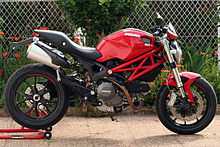
After leaving Cagiva and joining Aprilia in 2006, he designed the 2007 Aprilia Dorsoduro, 2008 RSV4, 2008 Mana, SL 750 Shiver of 2009,[38] and several Husqvarna models.[4] He also contributed to the Vespa/Piaggio 1+1 concept vehicle.[44]
Many of the Ducatis Galluzzi originally styled were later revised and updated by Pierre Terblanche, such as the ST series and the Monster 696 update of 2008. Terblanche later joined Galluzzi at Aprilia, where they have worked together on several new and revised models for Aprilia subsidiary Moto Guzzi. They contributed to the Moto Guzzi V12 series, with Le Mans, Strada, and X variants, displayed at EICMA in 2009.[45] Galluzzi described the challenge he and Terblanche faced revising the Moto Guzzi image by saying, "The Guzzi crowd is extremely conservative, but if we only concentrate on those, we are going to lose eventually. So these bikes are looking into the future." This is similar to the balance sought with earlier Ducati designs, but, "the advantage Guzzi has versus Ducati is that Ducati makes sportsbikes, Guzzi can do anything it wants because they’ve been doing it a long time and on all sorts of bikes. We are not in a box, we can do anything we want as long as we are able to make it."[46]
In 2012 Moto Guzzi introduced Galuzzi's "Art Nouveau style" California 1400 which breaks with traditional Harley-Davidsion-inspired cruiser style of the previous California. The new 1400 is more radically modern, similar to the latest power cruisers, the Harley-Davidsion V-Rod and Ducati Diavel.[17] The bike's new1,400 cc (85 cu in) engine expands Moto Guzzi's engine range, on top of the previous 1,200 cc (73 cu in) and 750 cc (46 cu in) displacement powerplants.[17]
Notes
- ↑ Ducati (2008), "1993 - The Monster", Ducati Heritige, archived from the original on 16 May 2008, retrieved 2011-01-16
- ↑ Ducati (2008), "The Turnaround Years", Ducati Heritige, archived from the original on 21 May 2008, retrieved 2011-01-16
- ↑ Euro Gossip, Motorcycle USA, October 20, 2006, retrieved 2009-06-14
- ↑ 4.0 4.1 4.2 4.3 4.4 4.5 4.6 4.7 Frank, Aaron (December 2008), "Miguel Galluzzi? The father of the Ducati Monster reasserts himself at Aprilia", Motorcyclist: 20
- ↑ 5.0 5.1 Ash, Kevin (3 June 2006), "This beast's a beauty Kevin Ash examines Ducati's latest Monster, the 695", The Daily Telegraph (London): 7
- ↑ 6.0 6.1 6.2 6.3 6.4 "Miguel Galluzzi", Art Center Car Classic '10, Art Center, 2009, retrieved 2010-04-20
- ↑ 7.0 7.1 West, Jim (August 2006), "Monster — Ducati's 2006 Monster Challenge: finally, a biker build-off worth watching", Motorcyclist: 58(5)
- ↑ 8.0 8.1 Ash, Kevin (2 August 2003), "The mother of all monsters", The Daily Telegraph, retrieved 2011-01-17
- ↑ "The way we were: famous motorcyclists recall their first motorcycles", Motorcyclist, November 2009
- ↑ 10.0 10.1 10.2 10.3 Melling, Frank (5 April 2007), "Memorable MC Cagiva Raptor 1000", MotorcycleUSA, retrieved 2011-01-18
- ↑ Holmstrom, Darwin; Nelson, Brian J. (2002), BMW Motorcycles, MotorBooks International, p. 156, ISBN 0-7603-1098-X, retrieved 2011-01-14
- ↑ 12.0 12.1 12.2 12.3 12.4 12.5 12.6 Cathcart, Alan (July 1993), "CW Riding Impression: Ducati M900; The Monster Lives", Cycle World (Newport Beach, California: Hachette Filipacchi Media U.S.) 32 (7): 42–46, ISSN 0011-4286
- ↑ "Aprilia.(Lane Changes) (press release)", Dealernews 42 (13), December 2006: 22
- ↑ 14.0 14.1 Ebert, Guido (16 October 2006), Aprilia taps new style manager (press release) 9 (14), Powersports Business, p. 29, retrieved 2011-01-16
- ↑ 15.0 15.1 15.2 15.3 15.4 Patton, Phil (April 18, 2012), "Going West, Piaggio Thinks Big for Next Generation of Scooters", The New York Times, retrieved May 6, 2012
- ↑ 16.0 16.1 Cameron, Kevin (April 17, 2012), "Will The Motorcycle Of The Future Come From Pasadena? Italian motorcycle designer Miguel Galluzzi talks two-wheel transportation", Cycle World, retrieved May 6, 2012
- ↑ 17.0 17.1 17.2 Ash, Kevin (May 4, 2012), "Moto Guzzi California 1400 launched", The Daily Telegraph, retrieved May 6, 2012
- ↑ 18.0 18.1 18.2 18.3 Falloon, Ian; Taglioni, Fabio (FRW) (2006), The Ducati Story: Racing and Production Models from 1945 to Present Day (4th ed.), Haynes, pp. 144–153, 192, ISBN 1-84425-322-8
- ↑ 19.0 19.1 19.2 Falloon, Ian (2004), Standard Catalog of Ducati Motorcycles 1946-2005, Iola, WI: KP Books, pp. 148–149, 156–170, ISBN 0-87349-714-7
- ↑ 20.0 20.1 Brown, Roland (14 August 1993), "Motoring: Ducati's heavenly Monster: The legendary Italian manufacturer has put its dark days behind it with a classic sportster, says Roland Brown", The Independent, retrieved 2011-01-19
- ↑ "'Monster' Ducati", American Motorcyclist (Westerville, Ohio: American Motorcyclist Association) 47 (2), February 1993: 26, ISSN 0277-9358, retrieved 2011-01-17
- ↑ 22.0 22.1 Ash, Kevin (November 2001), Ducati people: exploring the passion behind this legendary marque, Sparkford, Nr Yeovil, Somerset, England: Haynes, pp. 26–31
- ↑ 23.0 23.1 Thompson, Jon F.; Bonnello, Joe (1998), Ducati, Saint Paul, Minnesota: Motorbooks Workshop/MBI, pp. 87–92, ISBN 0-7603-0389-4, retrieved 2011-01-14
- ↑ Ash, Kevin (6 January 2002), "A gamble worth taking; On Two Wheels Long-term test Ducati Monster S4", The Daily Telegraph (London): 7
- ↑ Ash, Kevin (18 February 2006), "Forever young; First Ride Ducati's new S4Rs demolishes any idea that the Monster is ready for its bus pass, says Kevin Ash", The Daily Telegraph (London): 7, retrieved 2011-01-19
- ↑ 26.0 26.1 Dowds, Dowds (2002), Superbikes, Tangerine Press, ISBN 0-439-42466-6
- ↑ Kerr, Glynn (February 2008), "MC Design; Three Cheers!", Motorcycle Consumer News (Irvine, California: Aviation News Corp) 39 (2): 41, ISSN 1073-9408
- ↑ 28.0 28.1 Walker, Mick (2006), Motorcycle: Evolution, Design, Passion, JHU Press, pp. 200–201, ISBN 0-8018-8530-2
- ↑ 29.0 29.1 Walker, Mick (2001), Performance Motorcycles, Amber Books, Ltd. and Chartwell Books (Book Sales, Inc.), pp. 168–170, ISBN 0-7858-1380-2
- ↑ de Cet, Mirco (2001), The Complete Encyclopedia of Classic Motorcycles (3rd ed.), Rebo, p. 90, ISBN 90-366-1497-X
- ↑ Everitt, Charles; Gingerelli, Dain; Manning Michels, James (2011), 365 Motorcycles You Must Ride, MBI Publishing Company, p. 223, ISBN 0-7603-3474-9
- ↑ Falloon, Ian, The Honda story: road and racing motorcycles from 1948 to the present day, Haynes, 2005, p. 116, ISBN 1-85960-966-X
- ↑ "1993 Ducati Monster", American Motorcyclist (Westerville, Ohio: American Motorcyclist Association) 54 (1), January 2000: 38, ISSN 0277-9358, retrieved 2011-01-15
- ↑ Smith, Paul (21 September 2001), "Naked monster; pillion talk; A mighty beast it may be, but once tamed, this Monster inspires confidence, says Paul Smith; [1 Edition]", The Herald (Glasgow, UK): 4
- ↑ Kerr, Glynn (March 2008), "Design; The Perfect 10", Motorcycle Consumer News (Irvine, California: Aviation News Corp) 39 (3): 40–41, ISSN 1073-9408
- ↑ Ducati (2011), Model Year archive, retrieved 2011-01-15 (Nine models in 2005. 2008 Monster S4R S Tricolore, claimed 130hp - 95.7kW [sic] @ 9500rpm )
- ↑ West, Jim (October 2010), "2006 Ducati Monster Challenge - Family Album; Meet the motorcycle builders behind the bikes", Motorcyclist, retrieved 2011-01-15
- ↑ 38.0 38.1 Henning, Ari (December 2008), "Naked in the middle: updated icon or the new naked from Noale?", Motorcyclist: 68(8)
- ↑ Henshaw, Peter (2006), The Encyclopedia of the Motorcycle, Chartwell Books, p. 109, ISBN 0-7858-2144-9
- ↑ Catterson, Brian, "An Artier Ducati? Italy's next-generation sports-tourer, as seen from New Jersey", Cycle World (Newport Beach, California: Hachette Filipacchi Media U.S.) 43 (2): 43, ISSN 0011-4286
- ↑ Dealernews (February 1996), Milan Motorcycle Show. (1995) 32 (2), pp. 76(4)
- ↑ Brown, Roland (2005), The Ultimate History of Fast Motorcycles, Bath, England: Parragon, pp. 209–291, ISBN 1-4054-5466-0
- ↑ De Burton, Simon (4 May 2001), "Bonkers but brilliant motor cycles; [W Edition]", Evening Standard (London): 6
- ↑ Instablogs.com (9 Nov 2009), Vespa Piaggio 1+1 Generation concept is a minimalist vehicle for urban areas, retrieved 2011-01-14
- ↑ Waheed, Adam (11 November 2009), "Moto Guzzi V12 Concept First Look", MotorcycleUSA, retrieved 2011-01-17
- ↑ Siler, Wes (22 July 2010), "Pierre Terblanche and Miguel Galluzzi on the future of Moto Guzzi", Hell for Leather, retrieved 2011-01-19
References
- dePrato, Bruno (July 31, 2014), "Interview: Miguel Galuzzi, Motorcycle Designer; The man who designed the Ducati Monster, the head of Piaggio’s Advanced Design Center in California, promises something visionary at EICMA in November", Cycle World, retrieved August 1, 2014
| ||||||||||||||||||||||||||||||||||